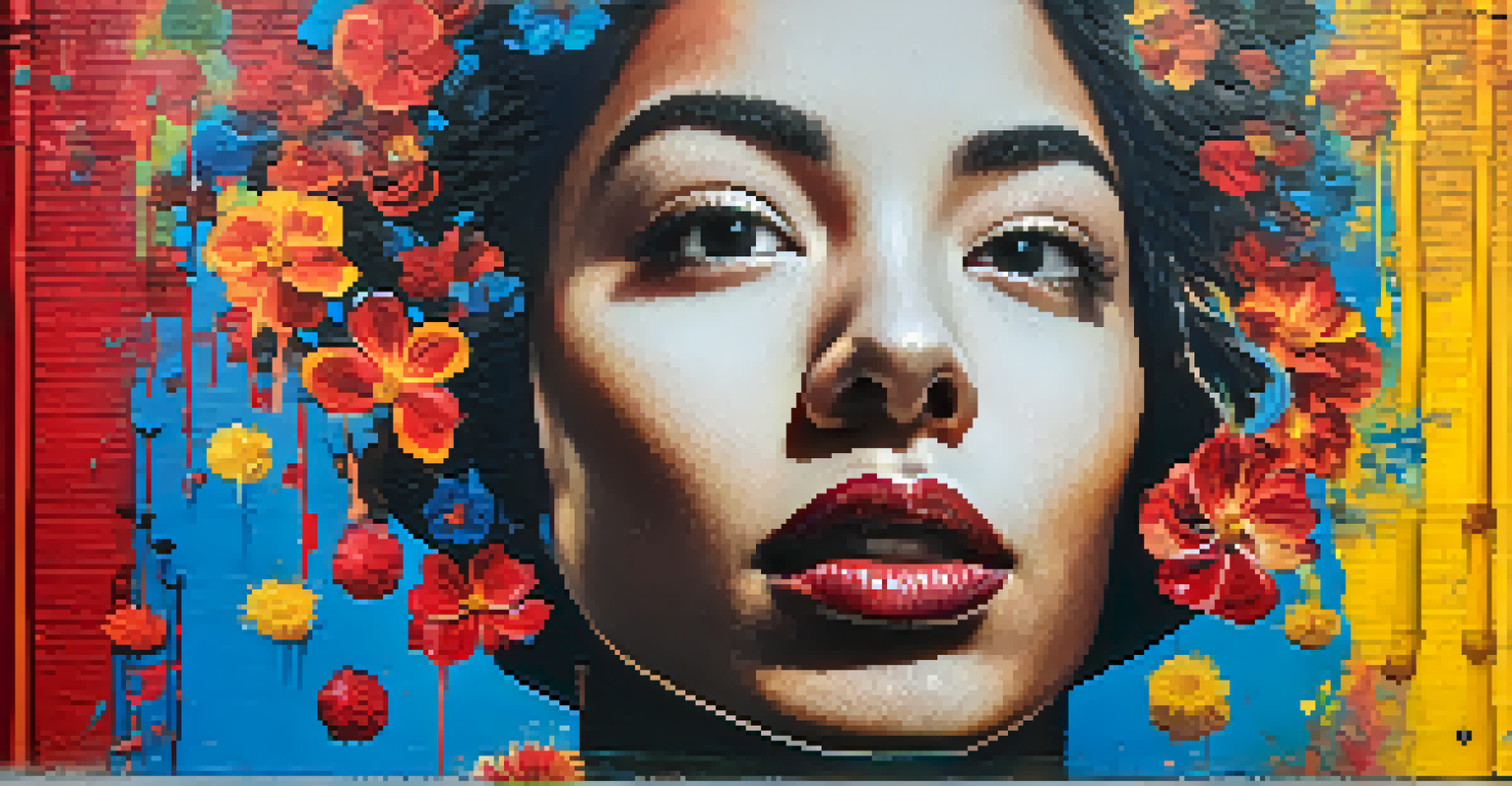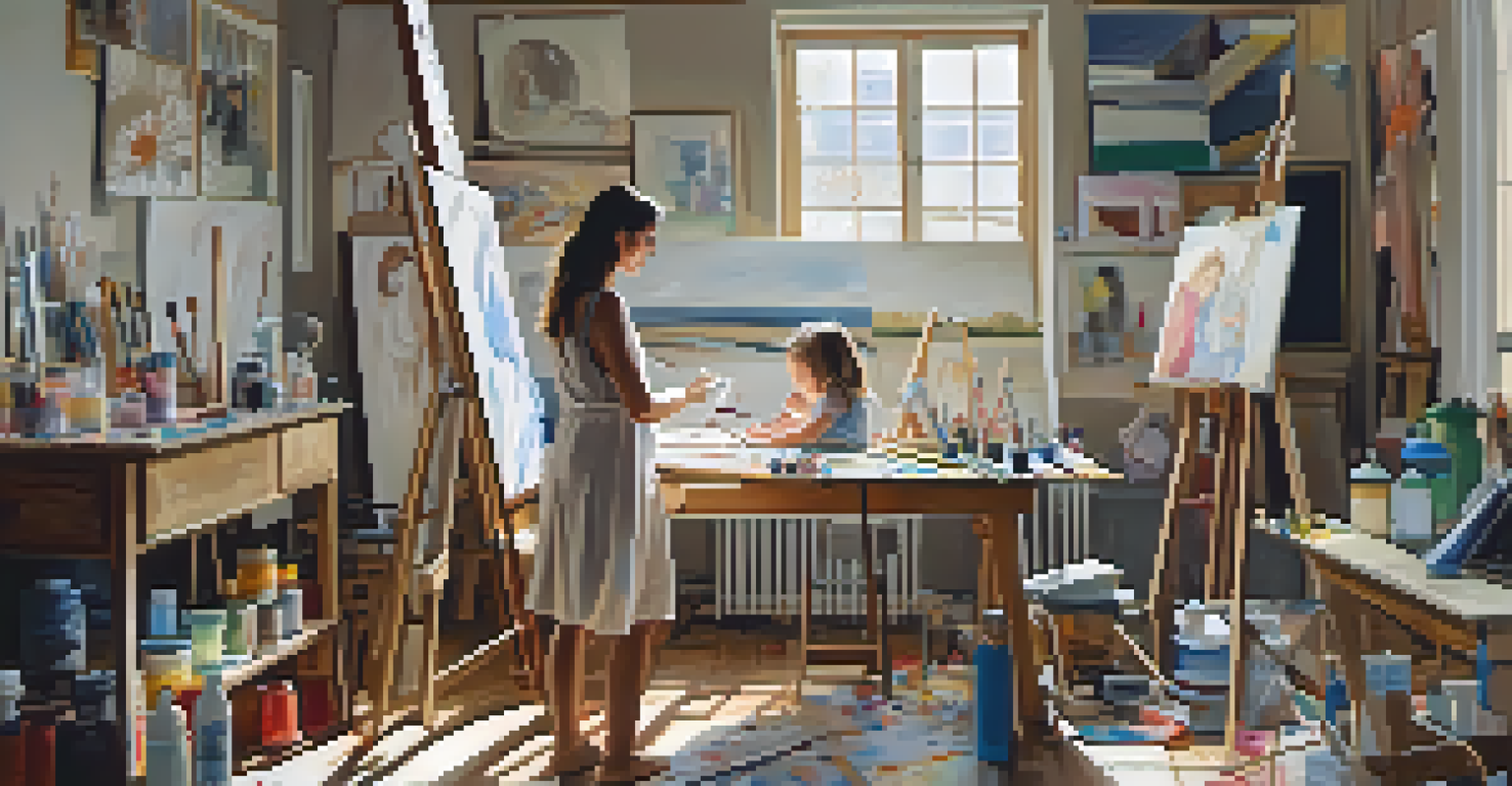Feminist Art: Painting as a Tool for Political Activism

Understanding Feminist Art: A Brief Overview
Feminist art emerged as a powerful movement in the late 20th century, aiming to address gender inequality and challenge traditional art narratives. Artists began to use their work as a platform to highlight women's experiences and societal issues. This movement not only redefined what art could represent but also emphasized the importance of women's voices in a historically male-dominated field.
Art is not a mirror held up to reality, but a hammer with which to shape it.
At its core, feminist art seeks to provoke thought and inspire action, often tackling themes like identity, body politics, and social justice. By creating art that resonates with personal and collective experiences, feminist artists encourage conversations around gender and power dynamics. This art is not just about aesthetics; it's a form of activism that invites viewers to reflect on their beliefs and societal norms.
Feminist art's legacy is evident in how it continues to influence contemporary artists today. It serves as a reminder that art can be a catalyst for change, transcending the canvas to provoke dialogue in broader cultural contexts. Understanding this foundation is essential to appreciating the role of painting in feminist activism.
The Role of Painting in Feminist Activism
Painting has historically been a medium through which artists express their ideas and emotions, making it a powerful tool in feminist activism. With its ability to convey complex feelings and narratives, painting engages viewers on both an emotional and intellectual level. This connection is crucial when addressing sensitive topics such as gender inequality and violence against women.

Through various styles and techniques, feminist painters convey messages that resonate with their audience. Whether using bold colors to evoke passion or softer tones to reflect vulnerability, these artists harness the power of visual storytelling. This approach not only captivates viewers but also prompts them to consider the societal implications behind the artwork.
Feminist Art as Activism
Feminist art serves as a powerful form of activism, addressing gender inequality and societal issues through visual storytelling.
Moreover, the accessibility of painting allows it to reach diverse audiences, from gallery goers to everyday people. This widespread engagement is essential for raising awareness and fostering conversations about feminist issues. In this way, painting becomes more than just an artistic expression—it transforms into a movement for change.
Key Themes in Feminist Painting
Feminist painting explores a variety of themes that challenge societal norms and highlight women's experiences. Common themes include body positivity, sexuality, motherhood, and identity, each addressing significant aspects of women's lives. By delving into these topics, artists can confront stereotypes and advocate for a more inclusive understanding of femininity.
I am my own muse, the subject I know best. The subject I want to better.
For instance, body positivity in feminist art often critiques unrealistic beauty standards imposed by society. Artists use their work to celebrate diverse body types and challenge the notion that there is one ideal form. This not only empowers women to embrace their bodies but also encourages a broader acceptance of all forms of beauty.
Another prevalent theme is the exploration of motherhood and its complexities. Feminist artists often depict the duality of motherhood—its joys and challenges—offering a nuanced perspective that is rarely represented in mainstream art. These themes collectively create a tapestry of women's experiences, fostering empathy and understanding among viewers.
Historic Feminist Artists Who Paved the Way
Several pioneering feminist artists have shaped the movement and its impact on society. Artists like Judy Chicago and Cindy Sherman challenged conventional representations of women in art and media. Their groundbreaking work not only pushed boundaries but also inspired countless others to explore feminist themes in their art.
Judy Chicago's iconic installation, 'The Dinner Party,' serves as a prime example of how art can honor women's contributions throughout history. This piece features place settings for 39 influential women, celebrating their legacies and sparking discussions about women's roles in society. Chicago's work exemplifies how feminist art can reclaim narratives that have been historically overlooked.
Legacy of Historic Artists
Pioneering feminist artists like Judy Chicago and Cindy Sherman challenged traditional representations of women and paved the way for future generations.
Cindy Sherman's photography challenges stereotypes by placing herself in various roles, highlighting the performative aspects of femininity. Through her art, Sherman encourages viewers to question the societal expectations placed on women. These artists, among many others, laid the groundwork for future generations to further explore feminist themes in their work.
Contemporary Feminist Artists Making Waves
Today, a new generation of feminist artists continues to push boundaries and engage with pressing social issues. Artists like Frida Kahlo, although not contemporary, are often revisited for their profound impact on feminist art. Modern artists, such as Tracey Emin and Kehinde Wiley, blend personal narrative with cultural commentary to spark conversations around gender, race, and identity.
Tracey Emin's work often draws on her own experiences, utilizing raw emotion to address themes of trauma and sexuality. Her candid approach invites viewers to confront uncomfortable truths, creating a space for dialogue around personal and collective struggles. This authenticity resonates deeply, making her work a vital part of contemporary feminist discourse.
Kehinde Wiley, known for his vibrant portraits of Black subjects, expands the representation of masculinity and femininity in art. By subverting traditional portraiture, he challenges the lack of visibility for marginalized voices. These contemporary artists exemplify how feminist art continues to evolve and adapt, remaining relevant in today's socio-political landscape.
The Intersection of Feminism and Other Movements
Feminist art often intersects with other social and political movements, creating a rich tapestry of activism. Issues such as racial equality, LGBTQ+ rights, and environmental justice are frequently addressed through the lens of feminist art. This intersectionality allows for a more comprehensive understanding of how various forms of oppression are interconnected.
For example, artists like Ai Weiwei incorporate feminist themes into broader discussions about human rights, using their platform to amplify marginalized voices. By addressing the intersection of feminism and other movements, artists can challenge systemic issues and advocate for a more inclusive society. This collaborative approach enhances the power of artistic activism.
Future of Feminist Art
The future of feminist art is poised to evolve with technology, enabling new forms of expression while remaining grounded in advocacy for social change.
Moreover, the intersection of feminism with other movements fosters solidarity and encourages collective action. Artists who embrace this approach highlight the importance of unity in the fight for justice, reminding us that change often requires collaboration across diverse communities. This interconnectedness is vital for creating lasting impact.
The Future of Feminist Art and Activism
As we look to the future, feminist art will likely continue to evolve, reflecting the changing landscape of society and activism. New technologies and platforms provide artists with innovative ways to engage audiences and spread their messages. From digital art to social media campaigns, the possibilities for feminist expression are expanding.
Emerging artists are increasingly incorporating technology into their work, using virtual reality and interactive installations to create immersive experiences. These contemporary methods can engage viewers in unique ways, allowing them to connect with feminist issues on a personal level. This evolution not only keeps the movement fresh but also ensures its relevance in a fast-paced world.

Ultimately, the future of feminist art hinges on its ability to adapt while remaining rooted in advocacy. As long as artists continue to address pressing societal issues and challenge the status quo, feminist art will remain a powerful tool for political activism. The journey of feminist art is far from over—it is a dynamic movement that will continue to inspire change for generations to come.